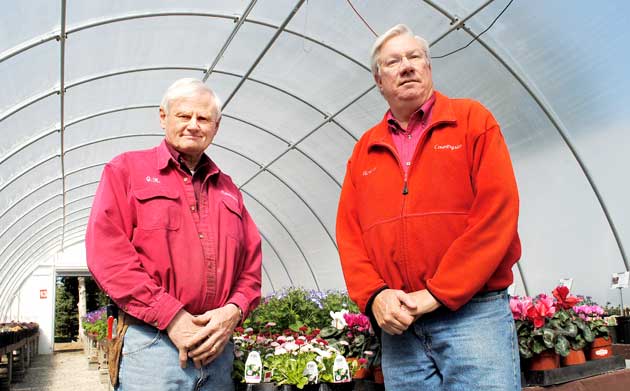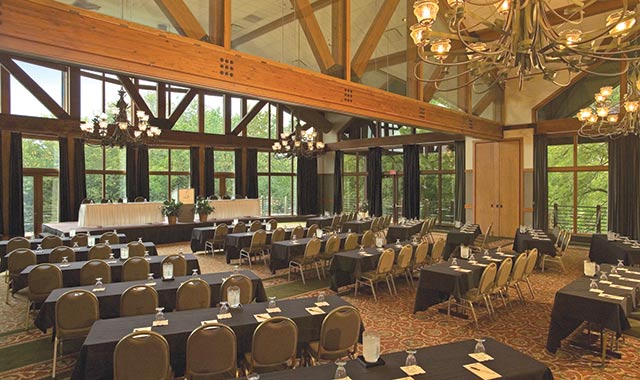They started as farmers, and have spent nearly 40 years tending to and growing their thriving flower shop and nursery. Discover why they love their work, and how they share that passion with the Crystal Lake community.

Growing a garden takes hard work, the right conditions and a little bit of luck. So, too, does growing a business. Richard Harms and Jim Riedl, co-owners of Countryside Flower Shop, Nursery & Garden Center, 5301 E. Terra Cotta Ave., Crystal Lake, have put the same care into their business as they’ve put into the flowers, trees and shrubs they’ve raised here since 1973.
That was the year the two Marian Central Catholic High School buddies bought the little florist and greenhouse from Bill and Katherine Hameder, who started it in 1959.
“We both have farming backgrounds,” says Riedl. “Richard started a fruit and vegetable business in high school, and I also sold a few things at a farm stand. When we first looked at Countryside, we both said it looked like a good business investment. We’ve been fortunate to grow with the community as Crystal Lake grew.”
The partners have cultivated an ever-growing enterprise, with Harms overseeing business operations, Riedl overseeing maintenance and the nursery, and Harms’ wife, Lori, coordinating greenhouse crops.
From the original 13-acre nursery/greenhouse, the company has expanded to 28 acres, with 21 hand-built greenhouses where the owners raise everything from tomatoes and strawberries to chrysanthemums and poinsettias. They also own a nursery near Union, where many of the blooming plants are grown. “Whenever we can, we raise our own plants,” says Riedl. “What we can’t grow, we buy from local suppliers as much as possible.”
On a sunny morning in mid-April, crews are buzzing, preparing for a busy season. A truck from Elburn is importing Easter lilies; a couple of women are sowing vegetable seeds in small pots; nursery crews are digging evergreens and shrubs for spring/summer plantings. Bright floral colors are everywhere.
Like nature, the greenhouse business works in cycles. By late April, the busy season begins. “In the next six weeks, Countryside will earn 40 percent of this year’s income,” estimates Harms. This is the annual rush, when homeowners spruce up their lawns and gardens, and when the floral shop handles orders for big occasions such as Easter, Mother’s Day and proms.
During this rush, the staff balloons to 90 employees, from about 40. The owners often put in 12-hour days, just to keep pace. During that time, they oversee harvesting of stock in the nursery; planting for future seasons; and the tending of flowers that are in bloom. Things settle down by July, when homeowners tend to stay home and enjoy the beautiful yards they’ve cultivated.
During this key season, Harms pays close attention to the weather. By his theory, this season looks promising for spring gardeners.
“It’s a guessing industry, and weather is a big factor,” he says. “If we have good weather during this six-week period, we’re generally going to have a successful year. If the weather is unseasonable, people don’t go out and work in their yards as often as they want or when they can. If that’s the case, they don’t have the time to plant as much.”
Countryside o keeps tabs on competing nurseries, including big box stores. To keep customers returning, it sticks to its roots, relying on the strong reputation of its locally-grown products and customer service. Little details can make a big difference.
“One important thing we do is answer our phones with a live receptionist,” says Harms. “So many places have a phone tree, where you have to do this and this and this before reaching a live person, if at all. Particularly at this time of year, people are looking for specific products. If they’re looking for a special perennial, we want to tell them that we have the variety they’re looking for and what sizes and colors are available. We also give them proper planting and care instructions. Then, we usually see them shopping here before the end of the day.”

Out in the nursery, Riedl always has his eye on the horizon, preparing for the next season. “The greenhouses are temperature-controlled for growing plants through late winter,” he says. “By June, we’re planting fall mums; a month later, poinsettias are potted to be ready for Christmas.”
“We always look forward toward the next season,” says Riedl. “The only reason to look back is to see where we can improve from the previous year. Looking forward, Christmas suppliers will start shipping product in May, June and July, so we’re already planning and are preparing for the next season well in advance.”
The partners are also sowing interest for new generations of gardeners. Baby Boomers are planting less, and the next generations are planting more sustainable gardens. “Younger home owners are getting passionate about their landscapes, especially when it comes to homegrown vegetables,” Harms says. “Every day there are more visitors, mostly younger people, coming in and saying, ‘My grandma raised vegetables and I want to show my kid how to do it.’”
Thanks to regular seminars, gardeners easily find tips and inspiration for starting their own gardens. The seminars usually take place one weekend a month. Recent series topics have included home-grown fruits; prevention of invasive insects; and new plant introductions.
“What we have to do is to make sure the young people who are gardening are successful at it,” says Harms. “Because they may not have the gardening experience or knowledge, novices can get discouraged if their crops don’t turn out as expected. We want to make sure we give them proper advice so they get it right the first time.”
Gardening isn’t just for adults, either. Schoolchildren and Scout troops make regular visits, touring the nursery and learning how to raise their own food and flowers. On this April day, staff member Kim Hartmann is chatting with the children about vegetables and gardening, quizzing them about plants and pointing out rows of potted strawberries.
“And a radish, what part do you eat?” asks Hartmann.
“The roots!” shout the seventh graders from Hannah Beardsley Middle School in Crystal Lake, all members of Beth Theiss’ biology class. During this annual outing, they sniff various herbs, learn about vegetable gardening, and pot their own plants to take home.
“What a wonderful thing they do here for our students,” says Theiss. “A lot of these kids don’t have any idea where their food comes from, and they learn so much here.”
Harms and Riedl have spent years cultivating the business, earning loyal customers and sharing what they love with the community. It’s a fitting environment for two old friends who love to work with the soil. ❚





















































